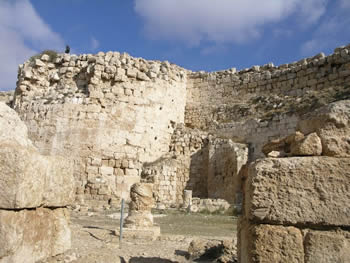










|
Search our Archives: » Home» History » Holidays » Humor » Places » Thought » Opinion & Society » Writings » Customs » Misc. |
Herodian By Jay Levinson True to his legendary paranoia, Herod built a lavish and heavily fortified palace today known as the Herodian. It is 15 kilometers south of Yerushalayim, and 5 kilometers south-east of Beis-Lechem. He spared no effort. He skimped on no luxury. He shunned no expense. But why at the edge of the Judean Desert?
The answer is to be found in Herod's flight from Jerusalem in 37 BCE, after he had served as governor. His rule was challenged, and he was attacked as he retreated. Miraculously, from his point of view, his life was saved in a military victory over his foes. Three years later, after forging new alliances in Rome, he returned to Jerusalem as king, and ordered that a palace be built on the site of his previous victory. Construction was started in 23 BCE and completed three years later. Workers artificially added height to a low hill, and built the Herodian. The building on the hill served Herod as summer palace, fortress and monument until he died in 4 B.C.E.
The palace was the epitome of unabashed pleasure. Round architecture pleased the capricious king's fancy, so the basic building and its four watchtowers were round. The reception area was large, but it was overshadowed by the bath house, which offered cold, lukewarm, and hot pools, with water stored in vast cisterns and heated by a steam system underneath the floor. Water was scarce at the edge of the desert, but that was of no consequence to Herod. Nor were these ordinary baths (at a time when bathing for common folk was a rare privilege). The bath area was a center of lounging and relaxation, where one could divert attention from serious matters for hours. 
Inside the walls at Herodian The commanding height of the edifice made it virtually impregnable, but everything comes to an end. Herod's son, Archelaus, inherited the Herodian, which he kept until 6 C.E., when he was banished by the Romans.
The second period in the Herodian's history began in 66 C.E., when Jews rebelling against the Romans took over the site. There they turned the reception area into a synagogue, and added a mikvah to the premises. After the destruction of Bayis Sheni and the fall of Yerushalayim, the rebelling Zealots used the Herodian as one of the three primary places of refuge from the pursuing rulers (in addition to Massada and Michvar, to be covered in future Annals). But, the Herodian also fell after strong attacks by the Roman army. 
Tunnel at Herodian The history of the Herodian did not stop there. During the Bar Kochva revolt the Herodian served as a command center and starting point for sneak attack operations --- call it guerilla warfare, if you will --- against the Romans. An extensive tunneling system from the top of the mountain was dug by Jewish forces, who would use hidden exits to initiate actions against the Romans.
After the Bar Kochva rebellion was defeated, the building went unused and collected dirt over the centuries. The Herodian was well-known from descriptions in Josephus, but it was not until 1962, then again in 1967, that archeologists began excavations under Jordanian direction. It was only after the Israeli excavations that started in 1972 progressed for several years that the previously unknown Bar Kochva tunnels were discovered. 
Mikvah at Herodian Several kilometers away is the hilltop of Asfar, mentioned in the apocryphal Macabees I 9. The site offers an excellent view of the area. It all gives an understanding of the Herodian's strategic value overlooking all approaches, with a clear view of Jerusalem on the horizon.

View from inside Herodian The only practical way to reach the Herodian is either with an organized tour or by private car. Walking from the nearest bus is absolutely not recommended for security reasons (though the site itself is quite safe). Be prepared for inclines and steps. Hours: 0800-1600. Entrance fee: adults NIS 22, children (5-18) NIS 11. Discounts for seniors are restricted to Israeli citizens. Allot about two hours to your visit. (Photographs by Mrs. Sheina Carlebach Berkowitz with the permission of The Israel Nature and National Parks Protection Authority.)
|
|

To the Current Index Page |

Write Us |

To the Big Archives Index Page |